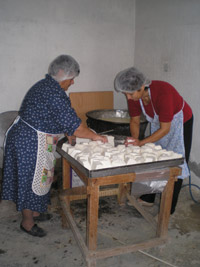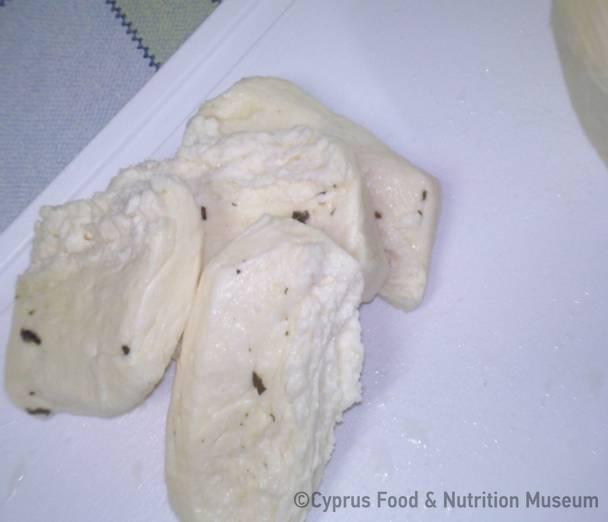It was turned into a a special coagulating powder used in the production of halloumi and other Cyprus cheese.
Name - Origin
Πυτία.
Dried and salted stomach lining of a newborn sheep, goat or pig, which had not eaten grass yet and was still being fed with milk (Rizopoulou-Igoumenidou, 2008). This is also noted by Georgios Loukas and Ioannis Erotokritos, in their Glossaries (Kypri 1979 [2002²], entry πυδκιά και μαγιά,η, 414; Kypri 1989, entry πυδκιά,η, 156). Pythkia is "dried stomach lining of a newborn animal, which contains enzymes that help milk to curdle and become cheese, halloumi, etc." (Petrou-Poeitou 2013, entry πυδκιά,123).
It is an enzyme secreted by the stomach lining. It belongs to the proteases (enzymes that hydrolyze albumin). In the acidic environment of the stomach, rennet causes milk to coagulate and, together with pepsin, causes the breakdown of casein. When it acts on the casein of milk, it forms paracasein, which in the presence of calcium ions gives calcium paracaseinate. This is insoluble and it settles and drags along a certain number of lipospheres and so cheese is formed. This is the reason for using rennet in cheese making.
Pithkia is found in large amounts in the gastric fluid of young children and animals, especially in the fourth stomach of ruminants. Adult individuals have only traces of rennet. This explains why milk casein is more easily digested in babies and young children than in adults.
A coagulant enzyme that is found in the gastric fluid of calves and is used in the coagulation of milk for the production of cheese (Babiniotis 2005, entry πυτιά,η, pp.1522-1523).
“We drain the milk with a strainer to remove impurities, and then we put it in the hartžin over fire to warm the milk and then we add rennet to curdle. We press the bag containing rennet in the hartžin so that rennet is released” (Mavrokordatos 2003, 314).
Functional and symbolic role
Kypri Th. D. (ed.) (1979 [2002²]), Υλικά διά την σύνταξιν ιστορικού λεξικού της κυπριακής διαλέκτου, Μέρος Α΄, Γλωσσάριον Γεωργίου Λουκά, Publications of the Centre for Scientific Research, XLI, Nicosia.
Kypri Th. D. (ed.) (1989), Υλικά διά την σύνταξιν ιστορικού λεξικού της κυπριακής διαλέκτου, Μέρος Γ΄, Γλωσσάριον Ιωάννου Ερωτοκρίτου, Publications of the Centre for Scientific Research, XIV, Nicosia.
Babiniotis G. (2005), Λεξικό της Νέας Ελληνικής Γλώσσας. Με σχόλια για τη σωστή χρήση των λέξεων. Ερμηνευτικό, Ορθογραφικό, Ετυμολογικό, Συνωνύμων-Αντιθέτων, Κυρίων Ονομάτων, Επιστημονικών Όρων, Ακρωνυμίων, Centre for Lexicology, Athens, Greece.
Mavrokordatos G. I. (2003), Δίκωμο: Το χθες και το σήμερα, Nicosia.
Petrou-Poeitou E. (2013), Από πού κρατάει η σκούφια τους. Λέξεις και ιστορίες από τον κόσμο της γεύσης, Epiphaniou Publications, Nicosia.
Rizopoulou-Igoumenidou E. (2008), «Τα γαλακτοκομικά προϊόντα στον ετήσιο κύκλο της παραδοσιακής ζωής στην Κύπρο», Η ιστορία του ελληνικού γάλακτος και των προϊόντων του (1st Workshop, Xanthi, 7-9 October 2005), Kalantzopoulos G. (ed.), Piraeus Bank Group Cultural Foundation, Athens, 401-423.
Additional information and bibliography
Demetra Demetriou



